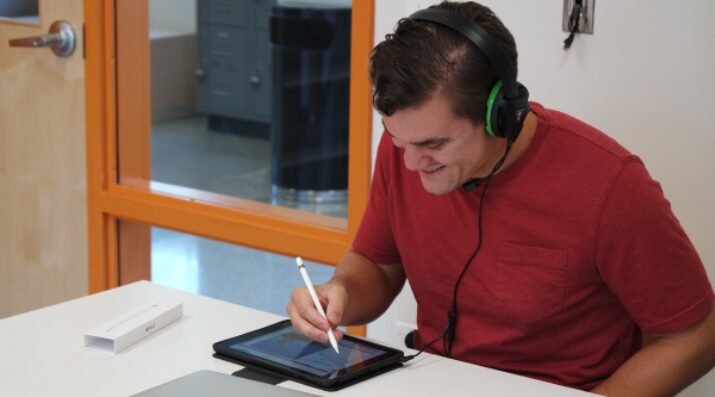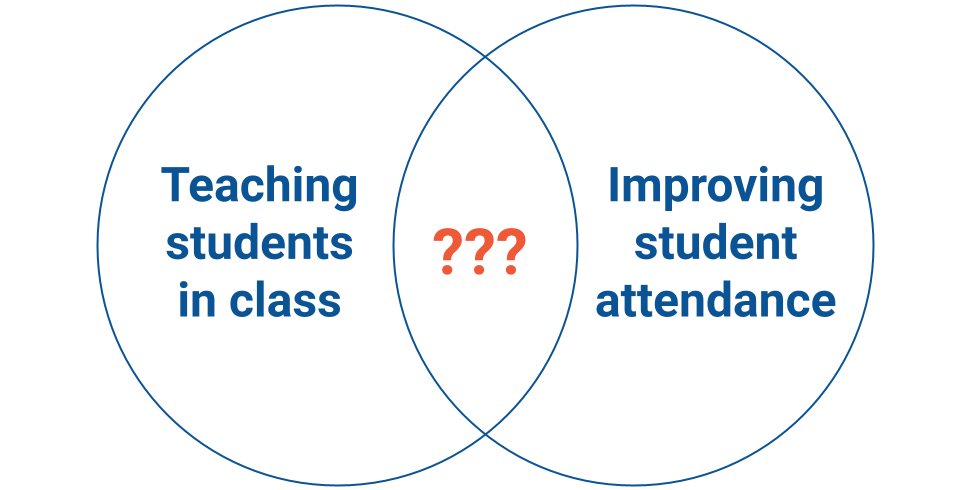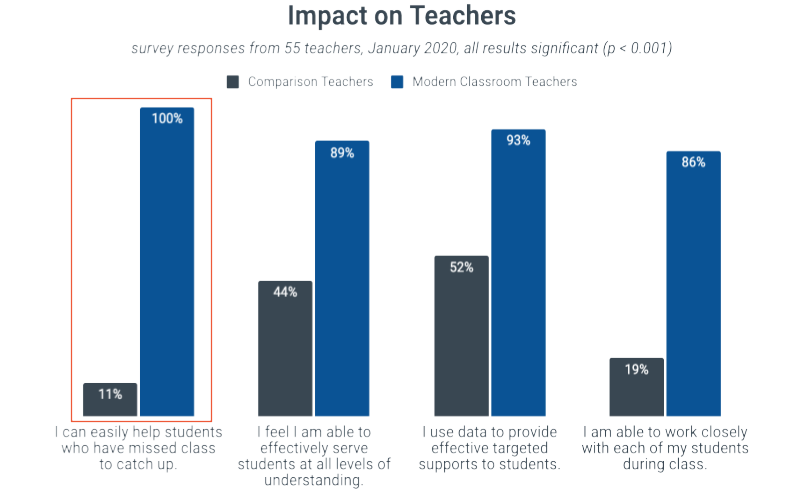How to Teach Students Who Aren’t There
Topics

We’ve all had the experience of truly purposeful, authentic learning and know how valuable it is. Educators are taking the best of what we know about learning, student support, effective instruction, and interpersonal skill-building to completely reimagine schools so that students experience that kind of purposeful learning all day, every day.
When chronically absent students do make it to school, they often feel lost and frustrated and behind. Self-paced, mastery-based learning can help them learn, and it can keep the rest of the class moving forward too.
Ten years ago, I started teaching math at a new high school. I was so excited! I spent weeks perfecting my first few lessons. The night before school started, I could hardly sleep.
My first period class was precalculus. There were 21 students enrolled. Then on the first day the bell rang and I took attendance… and there were 10 students there.
I was disappointed, but what could I do? I started my lesson anyway. But then every few minutes—sorry, hang on a sec—a new student would come in. As soon as I got into my rhythm—wait a second, hang on again—I’d be interrupted. Okay, you get the idea.
I thought this might just be the start of the school year. But it got worse! Some days at the start of class, I would have three students in my classroom. And by the end of class, I might have 10 students, or I might have 20.
This was so, so frustrating. If I taught a new lesson on Tuesday, the students who had been absent on Monday would be lost. And if I re-taught on Tuesday what I had covered on Monday, the students who had actually been there on Monday would be bored. I was constantly interrupted by students arriving late. And I knew that half the class was missing whatever I was teaching anyway, because they weren’t there.
I had no idea how to teach this class precalculus. So every day after that first-period class, I sat at my desk and considered quitting.
But I didn’t want to quit. And so I had to figure out: How could I teach students who weren’t there?
Existing Solutions Aren’t Enough
The first thing I did, of course, was Google it. I read a lot. But I noticed something very strange.
I found a lot of information about how to teach well. And I read a lot about how to get absent students to come to school. But there was almost nothing about what I should do to support those previously absent students when they actually returned to class.

The internet basically said: “Give them the notes, and have them make up the work at home.” But I knew my students. If they struggled to come to class in the first place, do you really think they’d be able to catch up on their own at home?
I started to get frustrated. There were literally millions of students all across the country who were chronically absent—but no concrete strategies for how best to help these students catch up. So whenever they returned to class, or even if they arrived late, these students were inevitably lost. I was failing them all.
There had to be a better way.
My Solution for Absent Students
Upon reflection I had come to realize that, if I taught every student the same lesson every day, I’d always leave my absent students behind. But what if I just stopped doing that?
Here’s what I did.
First, instead of standing at the board delivering my lessons, I recorded them on video. My students could watch the videos in class or at home. They could pause and rewatch if they had questions. And I wouldn’t get interrupted, because I wouldn’t be lecturing at the board. In fact, I could spend my time in class working closely with students, because they could get my content from the video.
My videos weren’t fancy. I would start a video call, hit record, and then explain something. It was literally just a recorded video call with myself. When I put it that way, it sounds kind of sad! But it was fun, too. And once I had these recordings, I could share them with my students, and they could learn from me anytime, anywhere. That was huge.
Second, I knew that if I taught using videos, my students would be all over the place. Some students would move really fast, and they’d be ahead of everyone else. Some students would need more time, and move slower. And some students wouldn’t be in class at all. I needed a way of tracking where they all were.
So I created a simple table like this, which showed where all of my students were:
When a student came to class, I could tell them exactly what to work on that day. I could also tell them whom to work with, and who could help answer their questions. For example, London and Troy could work on Lesson 1 while Adrian, Anna, and James worked on Lesson 2—and David could help his classmates or attempt Lesson 3. And if anyone missed a day of class, they could just come in and pick up where they left off. Every student always had something appropriately challenging to do! It was great.
Finally, I made sure that students really understood things before moving on. It’s really hard to understand complex things if you don’t know the basics. So I made sure every student knew the basics! Before I let Troy start Lesson 2, for example, I made him prove to me that he understood Lesson 1. If he didn’t understand it, he could go watch my video and try again. And as soon as he understood it, he could move straight ahead to Lesson 2.
This kind of learning was new for my students. They were used to just sitting and listening to me. But once they understood it, they really liked it. They could work at their own paces, and they had the time they needed to truly understand the material. It was great for their knowledge and self-confidence. And if they missed a day, no problem at all. They could just pick up where they left off. Every student was appropriately challenged—and appropriately supported—every day.
That doesn’t mean, of course, that I solved the problems caused by chronic absenteeism completely. My students who missed class had a lot to catch up on, and they didn’t always get through it all. And while my videos made it easier for these students to learn both in class and at home, they didn’t address the underlying issues that kept my students out of school in the first place. Chronic absenteeism remained a real challenge.
Yet now, when my students came back to class, they could actually succeed—and I could welcome them with the support they needed. Even if they had fallen behind the pace I had hoped they would achieve, they were engaged and achieving real mastery. Finally, my chronically absent students seemed happier to be in class! I know I was too. Those were wins for all of us.
This Method Works for Everyone
This method worked great for chronically absent students. But you know what? It didn’t just help my absent students. It helped my advanced students, who were ready to move faster than their classmates: they could progress through my videos and lessons as quickly as they wanted. It helped students who needed more time to learn, too: they now had the time they needed to reach mastery.
Many of my students, whether they attended class regularly or not, used to hate math class. They felt bored if they already understood the content, or lost if they lacked the prerequisite skills to master it. But now, with the time and support they needed to succeed, they actually started to enjoy it.
And this approach helped me! I was spending my time working closely with my students, getting to know them, and challenging them to excel. I started looking forward to first period every day. This approach worked for my second period, too, and every period after that. I had figured out a way to reach those absent students. It saved my career.
From Method to Movement
I suppose I could end my story there. But actually, that was just the beginning.
There was another math teacher at my school, named Kareem Farah. He was struggling with absences too, and he asked me how I handled them. I said to him, come and see!
So he came to my class, he liked what he saw, and a week later he was using the same approach. His videos were a little different, and he used a different kind of progress tracker, and his personality was different too. But my system worked for him too.
Pretty soon, other teachers were asking us for advice. English teachers, history teachers, and science teachers too.
So Kareem and I started a nonprofit, called the Modern Classrooms Project, in order to raise money and train our colleagues. And once we did, we found that this approach benefited them too! According to data we collected in partnership with researchers at Johns Hopkins University, the teachers we trained felt more capable of meeting their learners’ needs—especially when those learners missed class and needed to catch up.

Today, the Modern Classrooms Project has trained over 75,000 teachers, in all 50 states and over 150 countries around the world. Our teachers range from pre-K teachers to college professors. There’s a school in Zambia where every single teacher has taken our training, and every class uses our model. Zambia!
Because it turns out that a lot of teachers face similar challenges to those Kareem and I encountered.. Their students are absent too, or maybe their students are present but have different levels of background knowledge. They see this Modern Classroom model, with videos and progress trackers and mastery checks. They think “this can work for me.” And then they go make it work. They are happier, and their students are too. It is amazing to see.
This Starts With You
If you ask me, however, this is really only the beginning. Because there are millions of young people who are chronically absent. They have health issues, or they take care of family members, or they have jobs that keep them working late every night. There are more of them since COVID. They deserve support just as much as anyone else. Maybe more.
And for every student who is missing class, there’s a teacher who’s getting frustrated. That teacher wants the best for their students. That teacher is working long hours to plan great lessons. But if that teacher doesn’t know how to serve the absent students, that teacher is going to burn out.
Ten years ago, when I was doing those sad little video calls with myself, I had no idea I’d be writing an article like this. I didn’t plan to start a nonprofit, or to support teachers in Zambia. And I definitely didn’t intend to transform education. My goal was literally just to get through my first period every day without feeling like a complete failure.
But I found something that worked. It worked for my colleagues, too. And on Monday there are literally thousands of educators who are going to walk into their own first period classes, with their heads held high, and they are going to use the model I developed to ensure that the young people they serve truly learn—whether they happen to be in class that day or not. So I hope you will join them! Because that’s what our young people—and our educators—really need.
All images courtesy of the author.




